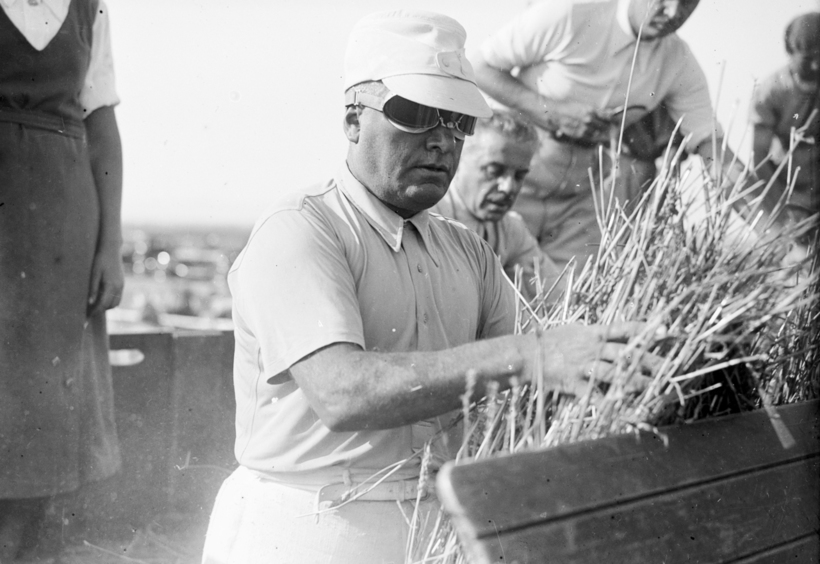
Mussolini harvesting wheat
Food has become an increasingly visible arena where individuals, communities, and nations debate and define their cultural identity, their social standing, their political outlook, and their economic success. Crops turn into commodities on the stock market, while trade regulations determine the fate of entire regions. Public concerns and the debates that emerge from them range from health and nutrition to organic methods, use of GMOs, support of local producers, and labor issues, among others.
The common thread between all of these aspects of the food system is that so much depends on the power distribution among all the stakeholders involved. Who has authority to decide what and how we eat? The next Farm Bill, which will determine the future of food production in the United States, is expected to enter negotiations by 2017 or 2018 at the latest. So much of our well-being lies in the politics of food that it is time we really start paying attention.
The close relationship between food systems and power, especially in totalitarian regimes, is not a new phenomenon. The recent death of Fidel Castro has reignited debates on how his political directives had a profound impact on what Cubans grew, bought, and ate. A new book by historian Tiago Saraiva, Fascist Pigs: Technoscientific Organisms and the History of Fascism, dives into how fascist dictatorships of the twentieth century (Mussolini in Italy, Hitler in Germany and Salazar in Portugal) embraced agriculture and husbandry, as well as the technological advances in those fields, to increase their control over food production in their countries and the lives of their citizens, while expanding their power structures.
The three dictators all embraced the ideal of the “organic” nation, closely connected with its generous soil and its inhabitants, who were the expression of pure and superior races. On the one hand, this constituted the ideological basis for the introduction of new plant and animal varieties that were intended to increase yields and to support the efforts of the three regimes toward complete autonomy (or autarky, as they preferred to say). According to Saraiva, these were not “thin scientific objects isolated from society,” but rather they bonded “science, technology, and politics together in a continuum.” On the other hand, the faith in science and progress provided a justification for the three regime’s expansionist policies in Europe and in Africa, reflecting the long held beliefs in the civilizing mission of the white man that had been ideological backbone of colonialism since the fifteenth century.
The three dictators all embraced the ideal of the “organic” nation, closely connected with its generous soil and its inhabitants, who were the expression of pure and superior races. On the one hand, this constituted the ideological basis for the introduction of new plant and animal varieties that were intended to increase yields and to support the efforts of the three regimes toward complete autonomy (or autarky, as they preferred to say). According to Saraiva, these were not “thin scientific objects isolated from society,” but rather they bonded “science, technology, and politics together in a continuum.” On the other hand, the faith in science and progress provided a justification for the three regime’s expansionistic policies in Europe and in Africa, reflecting the long held beliefs in the civilizing mission of the white man that had been ideological backbone of colonialism since the fifteenth century.
Saraiva focuses his research on both the existing literature about the relationship of fascism to science and technology, and on the close examination of a wide array of administrative, scientific, and political documents. He concentrates on a few specific cases: the introduction of laboratory-selected wheat varieties in Italy and Portugal, as well as the diffusion of genetically-controlled types of potatoes and pigs in Germany. To illustrate the impact of technoscientific organisms in the colonial efforts of the three regimes, the author examines coffee, rubber, cotton, and sheep.
The book explains that despite all of the interest in rural traditions and the glorification of farmers as the foundation of the nation, the fascist regimes had no intention to move back to the past, striving rather to assert what Saraiva defines as “a utopian vision of an organic alternative modernity.” The new communal dynamics were supposed to work as an antidote against the negative aspects of modernity, such as individualism, the supremacy of international plutocracy, and international instability. Class tensions were replaced by corporatist organizations where field laborers, sharecroppers, small farmers, and large landowners were supposed to cooperate with scientists, distributors, and food industries for the common good. In reality, the landowners relied on the regime to impose their domination over the rural population and drain them of resources.
We will discuss these topics in the public panel Food, Power, and Politics, which will take place at The New School on November 29 as part of the activities around the exhibition of artist Roxy Paine’s Dinner of the Dictators. These dynamics are not only remnants from our past—they define the present of our food system and will determine our future as individuals and citizens.

Comments are closed.